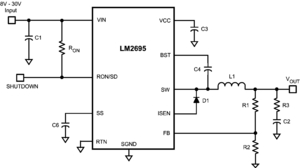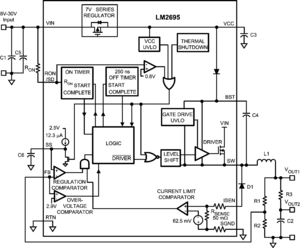| Part Number(s) (NSID) |
Top View | Type | Pins | MSL Rating | Peak Reflow | RoHS Status |
CAD Symbols | Models | Package Marking Format |
|---|---|---|---|---|---|---|---|---|---|
| LM2695MH/NOPB LM2695MH |
 |
TSSOP EXP PAD | 14 | 1 1 |
260 260 |
Detail | Download | N/A |
NSUZXYTT L2695 MH |
| LM2695MHX/NOPB LM2695MHX |
 |
TSSOP EXP PAD | 14 | 1 1 |
260 260 |
Detail | Download | N/A |
NSUZXYTT L2695 MH |
| LM2695SD/NOPB LM2695SD |
 |
LLP | 10 | 1 1 |
260 260 |
Detail | Download | N/A |
NS UZXYTT L2695SD |
| LM2695SDX/NOPB LM2695SDX |
 |
LLP | 10 | 1 1 |
260 260 |
Detail | Download | N/A |
NS UZXYTT L2695SD |
Description
The LM2695 Step Down Switching Regulator features all of the functions needed to implement a low cost, efficient, buck bias regulator capable of supplying 1.25A to the load. This buck regulator contains a 33V N-Channel Buck Switch, and is available in the thermally enhanced LLP-10 and TSSOP-14EP packages. The hysteretic regulation scheme requires no loop compensation, results in fast load transient response, and simplifies circuit implementation. The operating frequency remains constant with line and load variations due to the inverse relationship between the input voltage and the on-time. The current limit detection is set at 1.25A. Additional features include: VCC under-voltage lockout, thermal shutdown, gate drive under-voltage lockout, and maximum duty cycle limiter.
| • | High Efficiency Point-Of-Load (POL) Regulator |
| • | Non-Isolated Telecommunication Buck Regulator |
| • | Secondary High Voltage Post Regulator |
| • | Integrated 33V, N-Channel buck switch |
| • | Integrated start-up regulator |
| • | Input Voltage Range: 8V to 30V |
| • | No loop compensation required |
| • | Ultra-Fast transient response |
| • | Operating frequency remains constant with load current and input voltage |
| • | Maximum Duty Cycle Limited During Start-Up |
| • | Adjustable output voltage |
| • | Valley Current Limit At 1.25A |
| • | Precision internal reference |
| • | Low bias current |
| • | Highly efficient operation |
| • | Thermal shutdown |
Diagrams
Typical Application

|
Block Diagram
 |





